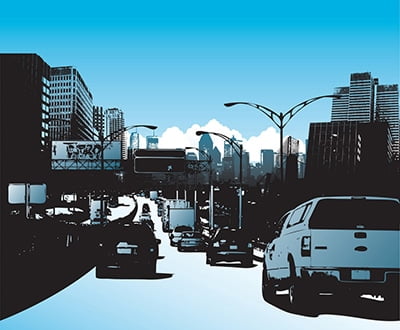Quiz: Entering a freeway
ADVERTISEMENT
Correct!
Wrong!
Correct!
Wrong!
Correct!
Wrong!
Correct!
Wrong!
Share the quiz to show your results !
Subscribe to see your results
I got %%score%% of %%total%% right
More Learning Options:
Loading…
ADVERTISEMENT
Entering a Freeway: Steps & Rules for Merging
So you’re driving along in your car, and suddenly there’s a flash of orange color. You glance over to see that another car has pulled onto the highway. What now?
If you are approaching an on-ramp to a highway/freeway, here is what you need to know about merging. If you are driving on a highway/freeway, here are the steps to take when you see cars pulling onto the road from an on-ramp.
 Steps for Entering a Highway/Freeway
Steps for Entering a Highway/Freeway
- Look ahead of you at the cars in the lane you are moving into and determine which lanes have more cars. From there, use your mirrors to change lanes if you wish so you may move into the lane with fewer cars.
- Once you have moved into a lane with fewer cars, signal your intent to merge by turning on your left turn signal and wait until it is safe (this means no one has come up alongside you and is speeding past you). Try not to do this too early, as other drivers may not realize that you are trying to merge.
- Look ahead again, make sure there is room for your car in the lane (if you cannot see far ahead, be cautious and do not enter), and then signal again to indicate that you are moving into the lane.
- Now that you have done all of these things, check your blind spot for cars and then signal again to merge fully into the other lane. If there is a car in your blind spot, wait until it passes before signaling to merge fully. If there are multiple cars in your blind spot, move over as much as you can without putting yourself or others at risk and hold the position until you can see ahead well enough to merge safely.
Be sure not to block others who may be trying to enter at an on-ramp further down the road if possible (in most cases, this isn’t possible). This is called ‘weaving,’ and it is very hazardous. Others will not expect you to suddenly move across multiple lanes in order to get into your lane, which makes this practice particularly dangerous when other cars are around you (you may be cut off or hit, others may crash trying to avoid you).
There are some instances where this method does not apply. For example, when it comes time to merge onto the Gardiner Expressway in Toronto, Ontario (or any place where there is an actual ‘ramp’), you still do what I’ve outlined above but only after slowing down because the ramp speeds limit is much slower than highway speed limits; therefore traffic tends to build upon the ramp.
Also, note that in Quebec, traffic laws require all vehicles merging onto a highway (from an on-ramp or two-lane road) to yield to any vehicle already on the highway before merging.
In conclusion, it’s important to be considerate of those behind you as well as those around you when merging since the safest option for everyone is for cars to stay in their respective lanes.

 Steps for Entering a Highway/Freeway
Steps for Entering a Highway/Freeway